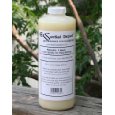 There are a huge variety of soap making oils, fats and butters that can be used in Soap Recipes for making bars of natural lye soap. Each oil has specific qualities and adds certain characteristics to you soap.
There are a huge variety of soap making oils, fats and butters that can be used in Soap Recipes for making bars of natural lye soap. Each oil has specific qualities and adds certain characteristics to you soap.
Soap making Oils and their Characteristics
Terms:
Saturated Fats – Oils that make a hard soap. Usually come in a solid form and need to be heated to a melt before using. Coconut, cocoa butter, Palm oil are examples.
Scenting Oils – There are two main types of scenting oils. Fragrance oils are man-made and contain alcohol. Essential oils are naturally occurring oils. The alcohol in fragrance oils can cause problems in soap making so essential oil’s are normally used in soap making. Essential Oil’s are more expensive and harder to find than Fragrance Oil’s but have better scent retention and will not ruin a batch of soap. The only time fragrance oils can be used safely is at the trace stage or during rebatching. Essential oils can be added at trace or in the base oil.
Superfatting Soap – This means that oils or fats have been left in the soap unconverted by the lye. This can occur in one of two ways. The amount of lye can be decreased to allow some fat/oil to remain in the finished soap. The second method is for oil or fat to be added at the trace stage after the mix had saponified. (In lay terms saponification means that the lye/water and oils have been mixed and brought to a trace stage where at this point the lye has been mostly neutralized. Any oil added at this stage will basically remain unchanged in the final soap bar) The method of adding additional fat to the soap mixture after it has saponified had a definite advantage in that it allows the soap maker to better control what oil is left in the soap. Adding the extra oil at this time keeps it in its natural state, and ready to instantly moisturize your skin as you use the soap. When using the super fat method at the trace stage make sure you use 1% as your excess fat lye amount. Otherwise the soap will be too oily because it will not only contain the oil you add at the trace stage but will also have excess fat from a lack of lye. You basically want all the original oils to become soap and the oils you add at trace to be left in the soap as moisturizers.
Superfatting soap by decreasing the lye content eliminates the step of adding oil at trace but decreases the control that the soap maker has over what oil is left in the soap. Here is an example. If 5% cocoa butter was added as part of the base oil (say 95% Olive Oil) and the lye amount was calculated for a 5% excess fat level the excess fat in the soap would be made up of a combination of Olive oil and cocoa butter with most of the excess fat being Olive oil. (5% of the cocoa butter would be left and 5% of the olive oil.) If the same batch was mixed using just Olive Oil at a 1% excess fat level and the cocoa butter was added at the trace stage you would know that the final soap bar contained 1% olive oil and 5% cocoa butter. The reason for this is that the cocoa butter would have in this case been unaffected by the lye since it was added after the soap had traced.
(NOTE – When adding oils at the trace stage (superfatting) be sure to use a lye calculatation that gives you about 1% excess fat. Otherwise your soap will be too oily. When using our Soap-Calc program or any other lye calculator do not include the oils that you will be adding at trace in the calculation)
Trace – The point at which the soap mixture starts to thicken. If you take a spoonful of the mixture and pour it over the soap it leaves a trace. Hence the name trace. At this point the solution is about 80-90% saponified and essential oils, superfatting oils, colors, additives, etc can be added without their characteristics being substantially altered by the saponification process.
Unsaturated Fat Oils – Oils that are in a liquid form. Alone they will create a soft spongy bar. They need to be mixed with saturated fats at the base oil stage in order to create a hard bar.
Soap making Oils:
Some of the oils below are for use at the trace stage so that they will remain in the soap. Others are added into the base to add certain characteristics such as lather or hardness. Most of the oil names below are “clickable” and will show you the price for the oil in different quantities and where to buy it.
Sweet Almond Oil
![]() Sweet Almond Oil is often used for superfatting soaps. It is a great moisturizer, makes a stable lather and helps condition the skin. It is recommended that you add 1 ounce per pound of fats to your soap batch at trace.
Sweet Almond Oil is often used for superfatting soaps. It is a great moisturizer, makes a stable lather and helps condition the skin. It is recommended that you add 1 ounce per pound of fats to your soap batch at trace.
Aloe Vera Liquid, Aloe Vera Gel
Aloe vera is used in creams and lotions. It is well known for being a healing and soothing agent for damaged, dry skin. It is also soothing and healing for burns, skin irritations, and raw open wounds. Liquid aloe vera may be added to cosmetic formulations, soaps, and straight on the skin. When adding to soap do it at the trace stage. You want as much to make it into the soap as possible.
Apricot Kernel Oil
Apricot kernel oil is often used for superfatting. It is also a good moisturizer and helps condition the skin. It is recommended that you add one or two ounces in every pound of fat at trace.
Avocado Oil
Avocado oil is a great moisturizer and is often used for superfatting soaps. Avocado oil contains vitamins A, D, and E, which makes it healing as well as moisturizing. Try it in a gentle baby soap. It is recommended that you add up to 30% as base oil.
Beeswax
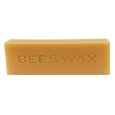 Beeswax has the sweet smell of honey. Beeswax makes a harder bar of soap and is also used in creams, lotions, lip balms and candle making. It contains a high percentage of unsaponifiables. At best, half of these substances participate in the normal soap making reaction. It is recommended that you add about 1 oz per lb. of oils in your base oils to make your soaps harder.
Beeswax has the sweet smell of honey. Beeswax makes a harder bar of soap and is also used in creams, lotions, lip balms and candle making. It contains a high percentage of unsaponifiables. At best, half of these substances participate in the normal soap making reaction. It is recommended that you add about 1 oz per lb. of oils in your base oils to make your soaps harder.
Calendula Oil
Has many therapeutic benefits and is known to successfully heal a variety of types of skin damage. (burns,wounds,dry skin) To superfat soap use 1 2/3 tablespoons per 5 lbs of soap at trace or use up to 20% added to other oils at the beginning of the soap making process.
Canola Oil
Canola oil is a good moisturizer but is less saturated than other fats, so it can be slow to saponify. Use it in place of more expensive oils like olive. Needs to be mixed with other saturated fats in order to speed up saponification. Use as a base oil up to 50%.
Castor Oil
Castor oil is often used to superfat. It attracts and holds moisture in the skin. You can use it in your base oils to produce a nice hard bar of soap. You can also add a 1-2% at trace for superfatting. Add it to your base oils at a rate of no more than 30% in the beginning of the soapmaking process.
Cocoa Butter
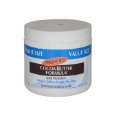 Cocoa butter is a wonderful product and is used in the base oils to make soaps harder. When used at trace as a superfatting oil it acts to lay down a protective layer which holds the moisture to the skin, so it is an excellent skin moisturizer/softener. It has a natural chocolate scent but it is also available in unscented versions. You can use it from anywhere about 1 ounce to a pound at trace, to 15% of your total base oils, depending on your preference.
Cocoa butter is a wonderful product and is used in the base oils to make soaps harder. When used at trace as a superfatting oil it acts to lay down a protective layer which holds the moisture to the skin, so it is an excellent skin moisturizer/softener. It has a natural chocolate scent but it is also available in unscented versions. You can use it from anywhere about 1 ounce to a pound at trace, to 15% of your total base oils, depending on your preference.
Coconut Oil
 Coconut oil makes soaps lather beautifully and is a very popular oil for soaps. It can be drying when it makes up too large portion of your soap’s base oils so make sure your recipe contains enough for lather and hardness but not too much. It will make a very hard, white bar of soap with abundant lather. It even lathers in very hard water or even sea water). Coconut oil is a saturated fat meaning it must be melted before lye is added. Use it at a percentage of no more than 20-30% in your base oils.
Coconut oil makes soaps lather beautifully and is a very popular oil for soaps. It can be drying when it makes up too large portion of your soap’s base oils so make sure your recipe contains enough for lather and hardness but not too much. It will make a very hard, white bar of soap with abundant lather. It even lathers in very hard water or even sea water). Coconut oil is a saturated fat meaning it must be melted before lye is added. Use it at a percentage of no more than 20-30% in your base oils.
Cottonseed Oil
Cottonseed oil produces thick and lasting lather, in addition to having emollient properties. It can be vulnerable to spoilage depending on the season, so keep this in mind when making batches with this oil. The Maximum recommended usage is 25% of total base oils.
Emu Oil
![]() Emu Oil is reported to help heal skin tissues and help draw other ingredients (like mint) down into your skin so they are more effective. The recommended usage of this oil is 1 ounce per pound at trace.
Emu Oil is reported to help heal skin tissues and help draw other ingredients (like mint) down into your skin so they are more effective. The recommended usage of this oil is 1 ounce per pound at trace.
Evening Primrose Oil
Evening primrose oil is absorbed quickly into skin and provides essential fatty acids that are said to help inhibit bacterial growth and encourage antibodies so the skin is better able to defend against infection or inflammation. It is not recommended as an additive in soaps made for oily complexions. It is recommended that you add 2 tablespoons per 5 pounds of soap, added at trace.
Grapeseed Oil
Grapeseed oil is a lightweight oil that absorbs into the skin quickly without leaving a heavy greasy feeling. Used in soaps as a superfatting oil. It is recommended that you add one ounce per pound at trace.
Hazelnut Oil
Hazelnut is an excellent moisturizer for soaps. It is low in saturated fatty acids, so use other more saturated fats to lessen your trace time and yield a harder bar. It is recommended that you make this part of your base at a rate of 20% of total oils.
Hempseed Oil
Hempseed oil is not as stable as some other oils and can spoil quickly. It creates a silky bar of soap even if it is only used as a superfatting oil. It is a less saturated fat, and since it is prone to spoilage, keep it as a small percentage of your mix to avoid having a soft, squishy soap that may spoil in a few months. Usage – As a Superfatting at 5% at trace or Base oil at 20-30% but no more than 40%.
Honey – (this is not an oil but it can be used as an additive)
Honey is also a humectant, meaning that it helps retain moisture on the skin much like glycerin does. It is recommended that you add 2 Tablespoons per pound of oils, added at trace.
Jojoba Oil
Jojoba helps to promote a stable lather and is good at conditioning skin. Because of its expense, it’s usually used to superfat soap batches or in shampoo bars. It is an excellent emollient for skin conditions like psoriasis, because it has a chemical composition very close to the skin’s own sebum. It is suitable for all skin types, beneficial for spotty and acne conditions, and great for sensitive or oily skin. It is reported to help to unclog the pores and remove any embedded grime. It also restores and conditions hair. When using Jojoba in soap, limit its usage to one or two ounces per pound at trace. Jojoba Oil naturally accelerates tracing in soap recipes. Used as a Superfatting oil.
Kukui Nut Oil
The kukui nut is native to Hawaii and is high in linoleic acid. It is quickly absorbed into the skin. Excellent for skin conditioning after excess sun exposure, as well as for the treatment of acne, eczema, and psoriasis. It offers just the right amount of lubrication without leaving you with a heavy greasy feeling. For soap making, use 2 tablespoons added to 5 lbs of soap at trace just before incorporating the essential oils to add richness to the soap. A higher percentage, 10-20% of the total fats in the base also makes an outstanding soap.
Lard
Lard is made from pig fat much like bacon fat. Its advantages are that it is cheap, easily obtainable, and makes a nice lathery, white bar of soap. This fat should be combined with vegetable oils such as coconut or palm oil to offset lard’s shortcomings. If you don’t use other oils the soap can tend to be soft and not work very well in cold water. Use Lard as a base oil. It is recommended to use 70% max of total oils.
Macadamia Oil
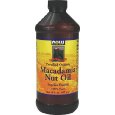 Macadamia is a luxurious and slightly expensive oil. It has a long shelf life so it can be purchased in quantity for a good price. It is a great addition to any soap formula. It is easily absorbed into the skin and acts as an emollient protecting skin cells from deterioration and thus leading to better condition for your skin. Use for superfatting your soap. It is recommended that you add 1 ounce per pound at trace.
Macadamia is a luxurious and slightly expensive oil. It has a long shelf life so it can be purchased in quantity for a good price. It is a great addition to any soap formula. It is easily absorbed into the skin and acts as an emollient protecting skin cells from deterioration and thus leading to better condition for your skin. Use for superfatting your soap. It is recommended that you add 1 ounce per pound at trace.
Mango Butter
Mango butter is a butter that is extracted from the mango fruit. It is a yellowish oil and has almost no scent. It is a great moisturizer and is recommended to be used to superfat batches. It is recommended that you add 15% of base or as a superfatting agent at 5% at trace.
Monoi Oil, also known as Monoi de Tahiti
Monoi oil is expensive but luxurious product made from coconut oil. It oil has wonderful moisturizing properties and is great for your skin. Use it as a base oil at 60% or higher.
Neem Oil
Extracted from the bark of the Neem Tree. This oil has the unique ability to treat a variety of skin disorders such as dandruff. It is recommended that you use it as a base oil up to 40%.
Olive Oil
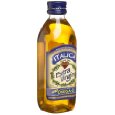 This is one of the more popular oils. Olive oil is excellent as a base oil. It is often combined with a little coconut or palm oil to give the bar lather and hardness. Avoid extra virgin olive oil. It is great for cooking but not for soap making. For soap, the lower the grade the better. Olive Oil prevents the loss of your skin’s natural moisture, softens skin and attracts external moisture to your skin. It helps keeps your skin soft, supple and younger looking. If you’re making an especially mild soap such as baby or no more tears soap use Olive oil. Use as a base oil up to 100% but normally around 80%.
This is one of the more popular oils. Olive oil is excellent as a base oil. It is often combined with a little coconut or palm oil to give the bar lather and hardness. Avoid extra virgin olive oil. It is great for cooking but not for soap making. For soap, the lower the grade the better. Olive Oil prevents the loss of your skin’s natural moisture, softens skin and attracts external moisture to your skin. It helps keeps your skin soft, supple and younger looking. If you’re making an especially mild soap such as baby or no more tears soap use Olive oil. Use as a base oil up to 100% but normally around 80%.
Palm Oil, also known as Vegetable Tallow
Palm oil makes a hard bar that cleans well and is also mild. It is a great substitute for tallow in all-vegetable soap formulas. The quality of Palm oil is going to be far superior to other vegetable oils that are filler oils. Palm oil is a universally popular soap oil and used in many expensive luxury soaps. Use is as a Base oil at 20 – 30%.
Palm Kernel Oil
Like Palm Oil, Palm Kernel oil makes a soap that is very hard and lathers well. It has most of the same qualities as palm oil. It is recommended that you use palm kernal oil as a Base oil at 20-30%
Peanut Oil
Peanut oil can be used in soap recipes to create a long-lasting lather. It is highly unsaturated though, so it is prone to spoilage. Because of this avoid using more than 20%. Peanut oil is similar to olive and castor oils and has a good amount of vitamin E. Do not use this if you are allergic to peanuts. It is recommended to use this oil as a base oil up to a 20% maximum.
Safflower Oil
Safflower oil is an unsaturated oil and should be used in combination with palm, coconut, or a similar oil to add hardness and lather to the bar. It is valuable for its moisturizing properties. Recommended to use it as Base oil up to 60%. 20% of total is popular ratio.
Sesame Seed Oil
Sesame oil is said to be good for Psoriasis, Eczema, Rheumatism, and Arthritis. It makes a good superfatting oil due to its moisturizing ability. It has a strong nutty scent. It makes a soft spongy bar unless used in conjunction with other oils such as palm or coconut. Use it as a 10% addition to base oils for best results.
Shea Butter
Shea butter is a wonderful superfatting agent and contains a large percentage of ingredients that do not react with the lye and will thus remain in the soap to nourish your skin. You can add it to your base at up to 20% of your total oils or use it as a superfatting agent at 1 – 2 tablespoons per 5 pounds of oils added at the trace stage.
Vegetable Shortening or Soybean Oil
Vegetable shortening is normally made out of soybean oil. It is cheap and readily available and produces a mild, stable lather. Use it in combination with other exotic or moisturizing oils. Use this as half of your fats to keep costs down. It is a good cheap filler oil and makes a very hard white bar when used alone or mixed with other oils. You should use vegetable shortening as a base oil or combine it with other, saturated oils for better results. Recommend use as base up to 50% of total oils.
Sunflower Oil
Sunflower oil is a less expensive alternative to olive oil. It contains Vitamin E, so it naturally resists spoiling since vitamin E is a natural preservative. Even so, don’t store it longer than six months. It is a less saturated oil so you want to combine it with other, more saturated oils such as coconut or palm oil. You should try to avoid using more than about 15-20% sunflower oil in your formula. It can make your soaps take longer to trace and to harden. It is recommended that you use it as a Base oil up to 20%
Wheat Germ Oil
This oil is a thick, sticky oil and also an antioxidant. It’s also very rich in vitamin E so it is not prone to spoiling. Wheat germ oil can be used to nourish dry or cracked skin and soothes skin problems such as eczema and psoriasis. It is also reported to help prevent and reduce scarring and may prevent stretch marks. Mature skin can especially benefit from wheat germ oil. Some people use it as a preservative in vegetable oils, soaps and toiletries. On its own, wheat germ oil oxidizes rapidly so it should be kept refrigerated. It is recommended that you add 1 ounce per pound added at trace.